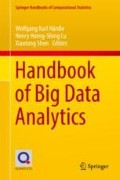Abstract
Given a neighborhood graph representation of a finite set of points \(x_i\in \mathbb {R}^d,i=1,\ldots ,n,\) we construct a frame (redundant dictionary) for the space of real-valued functions defined on the graph. This frame is adapted to the underlying geometrical structure of the x i, has finitely many elements, and these elements are localized in frequency as well as in space. This construction follows the ideas of Hammond et al. (Appl Comput Harmon Anal 30:129–150, 2011), with the key point that we construct a tight (or Parseval) frame. This means we have a very simple, explicit reconstruction formula for every function f defined on the graph from the coefficients given by its scalar product with the frame elements. We use this representation in the setting of denoising where we are given noisy observations of a function f defined on the graph. By applying a thresholding method to the coefficients in the reconstruction formula, we define an estimate of f whose risk satisfies a tight oracle inequality.
Access this chapter
Tax calculation will be finalised at checkout
Purchases are for personal use only
Notes
- 1.
Candès (2006) only hints at the proof; we provide a proof in the appendix for completeness.
References
Belkin M, Niyogi P (2002) Using manifold structure for partially labeled classification. In: NIPS, pp 929–936
Belkin M, Niyogi P (2003) Laplacian eigenmaps for dimensionality reduction and data representation. Neural Comput 15(6):1373–1396
Bickel P, Li B (2007) Local polynomial regression on unknown manifolds. In: Complex datasets and inverse problems: tomography, networks and beyond. IMS lecture notes, vol 54. Institute of Mathematical Statistics, Bethesda, pp 177–186
Candès E (2006) Modern statistical estimation via oracle inequalities. Acta Numer 15:257–325
Casazza P, Kutyniok G, Philipp F (2013) Introduction to finite frame theory. In: Casazza PG, Kutyniok G (eds) Finite frames, applied and numerical harmonic analysis. Birkhäuser, Boston, pp 1–53
Christensen O (2008) Frames and bases: an introductory course. In: Applied and numerical harmonic analysis. Birkhäuser, Boston
Coulhon T, Kerkyacharian G, Petrushev P (2012) Heat kernel generated frames in the setting of Dirichlet spaces. J Fourier Anal Appl 18(5):995–1066
Donoho DL, Johnstone IM (1994) Ideal spatial adaptation by wavelet shrinkage. Biometrika 81(3):425–455
Gavish M, Nadler B, Coifman RR (2010) Multiscale wavelets on trees, graphs and high dimensional data: theory and applications to semi supervised learning. In: Fürnkranz J, Joachims T (eds) ICML. Omnipress, Madison, pp 367–374
Haltmeier M, Munk A (2014) Extreme value analysis of empirical frame coefficients and implications for denoising by soft-thresholding. Appl Comput Harmon Anal 36(3):434–460. https://doi.org/10.1016/j.acha.2013.07.004
Hammond DK, Vandergheynst P, Gribonval R (2011) Wavelets on graphs via spectral graph theory. Appl Comput Harmon Anal 30(2):129–150
Han D (2007) Frames for undergraduates. In: Student mathematical library. American Mathematical Society, Providence
Kpotufe S (2011) k-NN regression adapts to local intrinsic dimension. In: NIPS, pp 729–737
Kpotufe S, Dasgupta S (2012) A tree-based regressor that adapts to intrinsic dimension. J Comput Syst Sci 78(5):1496–1515
Roweis S, Saul L (2000) Nonlinear dimensionality reduction by locally linear embedding. Science 290:2323–2326
Tenenbaum J, de Silva V, Langford J (2000) A global geometric framework for nonlinear dimensionality reduction. Science 290:2319–2323
Acknowledgements
The authors acknowledge the financial support of the German DFG, under the Research Unit FOR-1735 “Structural Inference in Statistics—Adaptation and Efficiency.”
Author information
Authors and Affiliations
Corresponding author
Editor information
Editors and Affiliations
Appendix
Appendix
1.1 Proof of Theorem 3
Theorem 3 states a oracle-type inequality which captures the relation of soft thresholding estimators \(\hat {f}_{S_s}=\sum _{k,l} S_s \left (\left \langle \,y,\varPsi _{kl} \right \rangle ,t_{kl}\right ) \varPsi _{kl}\) defined in (20.16) to the collection of keep-or-kill estimators on a Parseval frame. This result is known in the literature (see Candès 2006, Section 9), but we provide a short self-contained proof for completeness, modulo a technical result from Donoho and Johnstone (1994) for soft thresholding of a single one-dimensional Gaussian variable, which is basic for the Proof of Theorem 3.
Lemma 1
For 0 ≤ δ ≤ 1∕2, \(t=\sqrt {2\log (\delta ^{-1})}\) and \(X\sim \mathscr {N}(\mu ,1)\)
The proof of this lemma can be found in appendix 1 of Donoho and Johnstone (1994). Now we are able to prove Theorem 3.
Proof
First note that for y = τx, τ > 0, we have
Secondly we remark that
Considering now the risk of the soft thresholding estimator \(\hat {f}_{S_s}\) we get
by using inequality (20.6). By applying (20.24) and then (20.23) with \(t=\sqrt {2\log (n)}\) it follows that
Recalling the Parseval frame property \(\sum _{k,l} \left \lVert \varPsi _{kl} \right \rVert ^2=n\), we finally obtain
where we recognize the upper bound \(\sum _{k,l} \min \left (\sigma ^2\left \lVert \varPsi _{kl} \right \rVert ^2,a_{kl}^2 \right )=OB(f)\) for the oracle. □
Rights and permissions
Copyright information
© 2018 Springer International Publishing AG, part of Springer Nature
About this chapter
Cite this chapter
Göbel, F., Blanchard, G., Luxburg, U.v. (2018). Construction of Tight Frames on Graphs and Application to Denoising. In: Härdle, W., Lu, HS., Shen, X. (eds) Handbook of Big Data Analytics. Springer Handbooks of Computational Statistics. Springer, Cham. https://doi.org/10.1007/978-3-319-18284-1_20
Download citation
DOI: https://doi.org/10.1007/978-3-319-18284-1_20
Published:
Publisher Name: Springer, Cham
Print ISBN: 978-3-319-18283-4
Online ISBN: 978-3-319-18284-1
eBook Packages: Mathematics and StatisticsMathematics and Statistics (R0)

